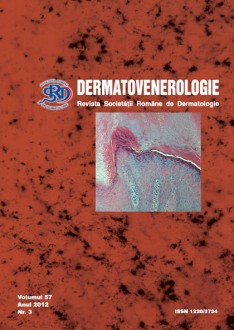Studii clinice si experimentale
Sindromul Bureau-Barrière: Studiu pe 11 cazuri
Sindromul Bureau-Barrière (acropatia ulceromutilanta sporadica) este o polinevrita de origine etanolica, insotita de leziuni cutanate si osteoarticulare.
Prezentam observatiile epidemiologice, clinicoevolutive si terapeutice in urma unui studiu retrospectiv pe 11 cazuri de sindrom Bureau-Barrière.
Bolnavi si metoda:
Lotul de bolnavi a cuprins 10 M, 1 F, cu varsta medie de 59,5 ani si un istoric al bolii de aproximativ 2,6 ani. Diagnosticul a fost stabilit pe baza examenului dermatologic, neurologic si a investigatiilor imagistice.
Tratamentul a constat in vitamine din grupul B, vitamina E, hemoreologice, hepatotrope, antibioterapie generala (la cazurile cu suprainfectie), corectarea dezechilibrelor nutritionale si ingrijiri locale cu solutii antiseptice, plus topice epitelizante.
Rezultate:
Toti bolnavii consumau cronic alcool, iar 9 erau fumatori. Sapte bolnavi afirmau expunerea indelungata la frig si umiditate, in context profesional. Au prezentat urmatoarele comorbiditati: hepatita cronica toxic etanolica (6 bolnavi); hepatita cronica mixta (1 bolnav); sindrom anemic (5 bolnavi); afectiuni gastrointestinale (3 bolnavi); dislipidemie (3 bolnavi); rozacee, eritem pelagroid si lipomatoza Launois-Bensaude (cate un bolnav).
Toti bolnavii consumau cronic alcool, iar 9 erau fumatori. Sapte bolnavi afirmau expunerea indelungata la frig si umiditate, in context profesional. Au prezentat urmatoarele comorbiditati: hepatita cronica toxic etanolica (6 bolnavi); hepatita cronica mixta (1 bolnav); sindrom anemic (5 bolnavi); afectiuni gastrointestinale (3 bolnavi); dislipidemie (3 bolnavi); rozacee, eritem pelagroid si lipomatoza Launois-Bensaude (cate un bolnav).
La noua bolnavi am obtinut ameliorarea leziunilor, mai evidenta la cazurile cu istoric recent de sindrom Bureau-Barrière, fara leziuni osoase severe. La doi pacienti, datorita leziunilor osoase grave si suprainfectiei, s-a ajuns la amputatii (un caz cu amputatie de haluce si alt caz cu amputatie de degete la un picior).
Concluzii:
Tratamentul complex precoce si renuntarea la consumul de alcool pot opri evolutia sindromului Bureau-Barrière si preveni complicatiile osoase, care necesita uneori amputatii mutilante.
Tratamentul complex precoce si renuntarea la consumul de alcool pot opri evolutia sindromului Bureau-Barrière si preveni complicatiile osoase, care necesita uneori amputatii mutilante.
Sindromul Bureau-Barrière este considerat o afectiune rara, insa procentul mare al consumatorilor cronici de alcool impune realizarea unor studii pentru cunoasterea incidentei reale.


